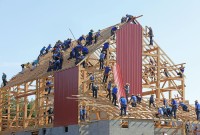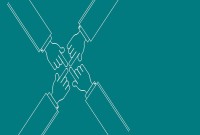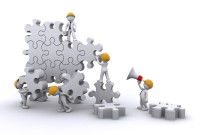- Home
- Business Processes
- Industry Knowledge
- Aerospace Industry
- Automotive Industry
- Banking Domain
- BFSI Industry
- Consumer/ FMCG Industry
- Chemicals Industry
- Engineering & Construction
- Energy Industry
- Education Domain
- Finance Domain
- Hospitality Domain
- Healthcare Industry
- Insurance Domain
- Retail Industry
- Travel and Tourism Domain
- Telecom Industry
- Leadership Skills
- eLearning
- Home
- Leadership Skills
- Leadership & Management
- Bureaucratic Management
Bureaucratic Management
Max Weber gave the theory of Bureaucratic Management in 1915. Bureaucracy is a specific form of organization defined by complexity, division of labor, professional management, and hierarchical management control. Weber's theory has two essential elements - organizational hierarchy and rules-based management. Weber made a distinction between authority and power and advocated that authority must be given to the most competent and qualified people.
Bureaucratic management as one of the schools of classical management emphasizes the need for organizations to function based on professional management and hierarchical management control.
Weber (1864-1920), was a contemporary of Fayol and was one of the major contributors to the management school of thought. He observed that nepotism, which is the hiring of relatives in the organization, based on their relationships with owners and regardless of their professional competence, capabilities, and qualities was prevalent in most organizations. Weber (1915) felt that nepotism was not the right way of running an organization, was grossly unjust, and eventually hindered both the progress of individuals as well as growth or organizations. He, therefore, identified the characteristics of an ideal bureaucracy. According to Weber, bureaucracy represents the most efficient organizational design. Taylor emphasized the separation of planning and doing tasks.
Bureaucracy word is derived from the German word 'bur' and means “office”, referred to organizations that operated on a rational basis. According to Weber, "bureaucracy is a highly structured, formalized, and impersonal organization. In other words, it is a formal organization structure with a set of rules and regulations". Many leaders follow the bureaucratic leadership style.
Advantages of Bureaucracy
Nowadays, the term "bureaucracy" is used to denote excessively complicated administrative procedures with multilayered systems and processes. Clubbed with rigidness in operations with mountains of paperwork, procedures, and rules bureaucratic model is believed to slow down an organization's capacity to achieve stated goals. However, the bureaucratic characteristics of organizations outlined by Weber have certain advantages.
- It helps remove ambiguities and inefficiencies that characterize many organizations.
- Undermine the culture of patronage that he saw in many organizations.
- Competence and creativity thrive within a bureaucracy as bureaucracy demands a higher level of education and self-direction.
- The structure of bureaucracy creates more job security and provides a better work-life balance to the employees.
- In a bureaucracy impersonal relationships are formed, equality is respected and provides everyone an equal opportunity to succeed.
- In a bureaucracy, specific roles and duties are assigned that enable managers to supervise work and facilitates a team-based environment.
- It encourages specialization and promotes problem-solving and cost efficiencies by putting the best people at the best jobs.
Sources of Power
Weber also made a distinction between authority and power. Weber believed that power educes obedience through force or the threat of force which induces individuals to adhere to regulations. According to Max Weber, there are three types of power in an organization:-
- Traditional Power
- Charismatic Power
- Bureaucratic Power or Legal Power
Features of Bureaucracy:
- Division of Labor.
- Formal Hierarchical Structure.
- Selection based on Technical Expertise.
- Management by Rules.
- Written Documents.
- Only Legal Power is Important.
- Formal and Impersonal relations.
Suggested Reading and Resources
Related Links
You May Also Like
-
Tools for Developing Your Team
If a manager has too many weak spots in the talent of the team, the ability to empower the team members to independently execute the project is impaired. Assignments fall behind schedule or stretch out because the needed skills or knowledge are not in place when needed. To successfully execute important projects, hiring talented people, and increasing the talents of existing staff are most important.
-
Certain generally accepted truths or principles of communication are important to consider when communicating with others. These principles hold true for all people in every culture. By understanding these principles, you will experience greater communication effectiveness. An effective communication system is one that achieved its objectives. Communication is effective where there are no barriers to communication.
-
Theory Z also called the "Japanese Management" style is a leadership theory of human motivation focused on organizational behavior, communication, and development. It assumes that employees want to enter into long term partnerships with their employers and peers. Offering stable jobs with an associated focus on the well-being of employees results in increased employee loyalty to the company.
-
There are four major factors in leadership called Leader, Follower, Communication, and Situation. The success of the leader is dependent on how the leader is effectively able to communicate and motivate followers to perform desired tasks using the appropriate leadership style best suited for the given situation. Interdependencies and dynamics of these four factors of leadership must be considered by a leader to be effective.
-
Many different types of teams have been identified by social scientists. Managers may encounter the diverse types of challenges while managing different kinds of teams. Challenges associated with Cross-Functional Teams might be different from that of a Geographically Dispersed Team or a Virtual Team. This article explores some common categories and subtypes of teams.
-
Thinking & Problem Solving Skills
Today's dynamic business world demands that you make decisions that significantly boost productivity and drive competitive advantage. But how do you know whether a decision will benefit the organization? And how do you know that the decisions are based on rational and statistical reasoning? Explore how to become a dynamic problem solver with the skills to make accurate decisions.
-
There are four characteristics of leadership that help us to understand the character of leadership as a concept. 1. Leadership is a process, 2. Leadership involves influence, 3. Leadership always occurs in a group context and 4. Leadership involves goal attainment. These are the four components that make up the character of the 'leadership' term and help us to define the leadership concept. All of these components of leadership have common characteristics.
-
Productivity is defined not in terms of the number of goods produced, but in terms of value-added per employee. Customers don’t really buy goods and services but in fact, they buy a value - something they value. The future is all about tangible products fulfilling intangible needs. Ideas like this can transform a business and provide them a competitive advantage to thrive in the future.
-
Management theories are the recommended management strategies that enable us to better understand and approach management. Many management frameworks and guidelines were developed during the last four decades.
-
In this study of power, Raven identified five bases of power as coercive, reward, legitimate, referent, and expert. The 5 Types of Power can help you decide when it is appropriate to use a particular type of power in important situations. Leadership involves authority and it is very important for leaders to understand what type of power they're using.
Explore Our Free Training Articles or
Sign Up to Start With Our eLearning Courses

About Us
Learning
© 2023 TechnoFunc, All Rights Reserved










